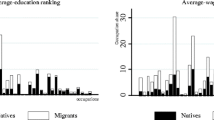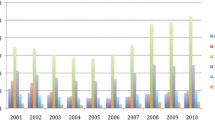Abstract
This paper identifies the factors influencing earnings gaps between migrants belonging to old immigrant groups (defined as those with long established migration linkages with the receiving country) and those belonging to new immigrant groups. Earnings are conceptualized as a function of human capital, decomposed into the portion acquired in the home country and the portion acquired in the receiving country. It is hypothesized that poor transferability of human capital acquired at home dampens wages more for new than for old immigrant groups. Further, it is hypothesized that upon arrival in the destination, new immigrant groups accumulate human capital faster than old immigrant groups. The empirical analysis focuses on Albanians in the United States as a representative of a new immigrant group and Italians as a representative of an old immigrant group. The analysis is based on pooled data from the 2000 US Census 5 % sample, and the 2001–2007 American Community Survey (ACS) 3 % sample. Findings suggest that (1) Albanian immigrants earn substantially less than Italian immigrants; (2) human capital acquired at home has a positive impact on wages, but the level of human capital transferability is low for Albanians; (3) upon arrival, both Italian and Albanian immigrants accumulate human capital, but the speed of human capital accumulation is faster for Albanians than for Italians.
Similar content being viewed by others
Notes
Neither Albania nor Italy has a bilateral agreement with the United States for highly skilled workers.
Several foreign credential evaluation services exist in the United States, but there is no universally employed set of standards when evaluating foreigners’ credentials (USNEI 2008).
For Albanians, the segregation index is a little higher, amounting to 0.52. This result is, however, somewhat expected since Albanians are a much smaller immigrant group than Italians, and the segregation index is sensitive to population size. The dissimilarity index between Italians and Albanians is low, amounting to only 0.26.
The permanent admission policies of the United States have the four objectives: family unification, meeting labor demands in certain occupations, provision of refuge for persecuted persons, and ensuring diversity. Most immigrants admitted to meet the diversity goal belong to new immigrant groups thus come from countries with traditionally low immigration rates. Every year, the United States admits up to 50,000 diversity immigrants, and the maximum per country is 3,850.
The goal of the Bologna Process is the creation of a European Higher Education Area to facilitate the mobility of students and staff throughout the region, quality assurance, and recognition of foreign degrees. Italy joined the process in 1999 and Albania joined in 2003. American universities use involvement in the Bologna Process as a signal of quality.
Steven Ruggles, Matthew Sobek, Trent Alexander, Catherine A. Fitch, Ronald Goeken, Patricia Kelly Hall, Miriam King, and Chad Ronnander. Integrated Public Use Microdata Series: Version 4.0 [Machine-readable database]. Minneapolis, MN: Minnesota Population Center [producer and distributor], 2009. http://usa.ipums.org/usa/.
Since the data refer to different years, wages are deflated with the consumer price index for the years 2000–2007, using 2007 as the base price.
Age at entry is calculated by subtracting age at time of survey from the duration in the United States.
Persons speaking English at home are categorized as English proficient. In addition, for persons speaking a language other than English at home, the ACS and census questionnaires include the question: How well does this person speak English? We categorized respondents as proficient in English if they chose to answer well or very well. For respondents answering not well and not at all the dummy variable Engproficient takes on the value zero.
There is no universal minimum sojourn length for citizenship (Duncan and Waldorf 2009), and the five year requirement does not include the years during which an immigrant had a temporary visa but only refers to the number of years since acquiring a permanent residence permit (green card). Immigrants married to US residents are eligible to apply for US citizenship three years after being issued a green card.
Note that others point out that, in order to avoid the negative effects of brain drain, changes in migration flows are not sufficient and must be accompanied by structural changes in the country itself (see, for example, Glytsos 2008).
State-level information is the smallest level of geographic detail available in the IPUMS data across all samples utilized in the analysis. In order to incorporate data at a more detailed geographic level, the number of observations available would have been significantly reduced.
References
Albania 2009 progress report (2009) Commission of the European Communities Brussels, 14 October 2009
Barro R, Lee J (2010) A new data set of educational attainment in the world, 1950–2010. NBER Working Paper, No 15902
Bauer T, Lofstrom M, Zimmermann K (2000) Immigration policy, assimilation of immigrants and natives’ sentiments towards immigrants: evidence from 12 OECD countries. Swed Econ Policy Rev 7:11–53
Borjas GJ (1994) The economics of immigration. J Econ Lit 32(4):1667–1717
Carliner G (1980) Wages, earnings and hours of first, second and third generation American males. Econ Inquiry 18:87–102
Cavaioli FJ (2008) Patterns of Italian immigration to the United States. Cathol Soc Sci Rev 13:213–229
Chiswick BR (1978) The effect of Americanization on the earnings of foreign-born men. J Polit Econ 86:897–921
Chiswick B, Miller P (2009) The international transferability of immigrants’ human capital. Econ Educ Rev 28:162–169
Duncan NT (2008) Brain drains, brain gains and migration policies. Chapter 13. In: Poot J, Waldorf B, van Wissen L (eds) Migration and human capital. Edward Elgar, Cheltenham
Duncan NT, Waldorf B (2009) Becoming a US citizen: the role of immigrant enclaves. CityScape 11(3):5–28
Ekberg J, Hammarstedt M, Shukur G (2010) Immigrant-native earnings differentials: SUR estimation applied on three generations. Ann Reg Sci 45:705–720
El-Araby Ali A, Ragan JF Jr (2010) Arab immigrants in the United States: how and why do returns to education vary by country of origin? J Popul Econ 23:519–538
Florax RJGM, de Graaff T, Waldorf B (2005) A spatial economic perspective on language acquisition: segregation, networking and assimilation of immigrants. Environ Plan A 37:1877–1897
Friedberg RM (2000) You can’t take it with you? Immigrant assimilation and the portability of human capital. J Labor Econ 18:221–251
Gërmenji E, Gedeshi I (2008) Highly skilled migration from Albania: an assessment of current trends. Center for Economic and Social Studies in Tirana, Albania. Globalisation Working Paper T-25
Glytsos NP (2008) Theoretical considerations and empirical evidence on brain drain: grounding the review of Albania’s and Bulgaria’s experience. Int Migr 48(3):107–130
Hatton TJ, Leigh A (2011) Immigrants assimilate as communities, not just as individuals. J Popul Econ 24:389–419
Hu X, Sumption M (2011) Scientists, managers, and tourists: the changing shape of European mobility to the United States. Migration Policy Institute, Washington
Kosta B (2004) Albania: looking beyond borders. Migration Information Source http://wwwmigrationinformationorg/Feature/displaycfm?id=239
Kule D, Mançellari A, Papapanagos H, Qirici S, Sanfey P (2002) The causes and consequences of Albanian emigration during transition: evidence from micro-data. Int Migr Rev 36(1):229–239
Lazear E (1999) Culture and language. J Polit Econ 107(S6):95–126
Ruggles S, Sobek M, Alexander J, Genadek K, Goeken R, Schroeder M. (2010) Integrated public use microdata series: version 5.0 (Machine-readable database). Minnesota Population Center, Minneapolis, MN (producer and distributor)
Stewart JB, Hyclak T (1984) An analysis of the earnings profiles of immigrants. Rev Econ Stat 66(2): 292–296
US Immigration and Naturalization Service (2009) Yearbook of immigration statistics. http://wwwdhsgov/files/statistics/publications/LPR09shtm
USNEI (2008) Recognition of foreign qualifications. http://www2edgov/about/offices/list/ous/international/usnei/us/edlite-visitus-forrecoghtml 2/26/2008
Vullnetari J (2007) Albanian migration and development: a state of the art review. IMISCOE Working Paper No 18
Waldorf B (1994) Assimilation and attachment in the context of international migration: the case of guest workers in Germany. Papers in regional science. J Reg Sci Assoc Int 73(1):1–26
Waldorf B, Beckhusen J, Florax RJGM, de Graaff T (2010) The role of human capital in language acquisition among immigrants in US metropolitan areas. Reg Sci Policy Pract 2(1):39–49
Acknowledgments
The authors thank two anonymous reviewers for their valuable input. They also appreciate the helpful comments on earlier versions of the paper, offered by Will Masters, Otto Doering, Elizabeth Dobis, Anna Flaig, Julia Navarro, Samuel Brown, Jing Liu, Shelley Clarke, and the participants of the SHaPE seminar in the Department of Agricultural Economics, Purdue University.
Author information
Authors and Affiliations
Corresponding author
Rights and permissions
About this article
Cite this article
Mane, K.M., Waldorf, B.S. Human capital and wages: a comparison of Albanian and Italian immigrants. Ann Reg Sci 51, 53–72 (2013). https://doi.org/10.1007/s00168-012-0532-2
Received:
Accepted:
Published:
Issue Date:
DOI: https://doi.org/10.1007/s00168-012-0532-2




